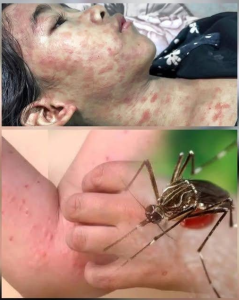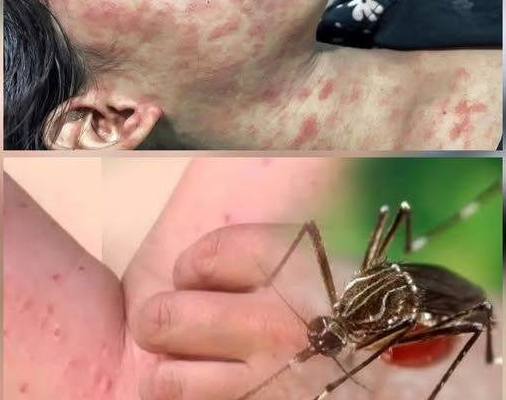ALERT: New Disease Outbreak in China — Over 7,000 Cases Reported, Symptoms and Risks Revealed
A new outbreak of a mosquito-borne disease has emerged in southern China, raising public health concerns both nationally and internationally. The outbreak, primarily concentrated in Guangdong Province, has now surpassed 7,000 confirmed cases, according to official reports. Local authorities are scrambling to contain the spread, implement emergency measures, and educate the public on prevention strategies. The outbreak serves as a stark reminder of how rapidly infectious diseases can escalate when ecological and human factors align.
Understanding the Disease
The disease in question is the chikungunya virus (CHIKV), an RNA virus transmitted primarily through the bites of infected female mosquitoes, mainly Aedes aegypti and Aedes albopictus. These same mosquito species are known vectors for dengue, Zika, and yellow fever. Once a mosquito bites an infected person, it can carry the virus to the next person it bites, creating a cycle of transmission in areas where the mosquito population is abundant. Unlike airborne illnesses such as influenza or COVID-19, chikungunya is not spread directly from person to person through casual contact.
Chikungunya is not new globally, but this outbreak in China is significant because it represents one of the largest local outbreaks in mainland China to date. Previously, cases in China were sporadic or imported from other regions. This outbreak indicates that the virus has established local transmission in Guangdong, a densely populated area with a warm, humid climate that favors mosquito breeding.
Symptoms of Chikungunya
Chikungunya infection usually begins abruptly within 3 to 7 days after a person is bitten by an infected mosquito. The most common symptoms include:
-
Sudden high fever — often reaching 39°C or higher.
-
Severe joint pain — particularly in the hands, wrists, knees, and ankles; sometimes described as debilitating.
-
Swelling and stiffness in joints — which may persist for weeks or months.
-
Muscle pain and fatigue — patients often experience extreme tiredness.
-
Headache and rash — rash can appear a few days after fever onset.
Most individuals recover fully within one to two weeks, but in some cases, joint pain can persist for several months, affecting quality of life and daily functioning. Severe complications are rare but can occur in newborns, the elderly, or those with underlying health conditions. To date, the current outbreak in China has not reported widespread fatalities, though ongoing monitoring is essential.
Why the Outbreak is Spreading
Several factors have contributed to the rapid spread of chikungunya in southern China. First, the general population in Guangdong has low pre-existing immunity to the virus, making a large segment of residents susceptible to infection. Second, the region’s climate — warm, humid, and prone to heavy rainfall — provides ideal conditions for mosquito breeding. Standing water from puddles, containers, flower pots, and other sources allows Aedes mosquitoes to proliferate quickly.
Urbanization and high population density further amplify the risk. Cities like Foshan, the epicenter of the outbreak, have dense housing and frequent human movement, increasing the likelihood of mosquitoes biting multiple hosts in a short period. Additionally, international travel plays a role, as imported cases may introduce the virus into previously unaffected areas.
Public Health Response
Chinese authorities have implemented multiple strategies to contain the outbreak and protect residents. Key measures include:
-
Mosquito control programs — large-scale insecticide spraying, removal of standing water, and the use of drones to identify mosquito breeding sites.
-
Household and business compliance — citizens are encouraged to eliminate standing water, with fines imposed for failure to comply. Some fines have reportedly reached up to 10,000 yuan.
-
Hospitalization protocols — confirmed cases may be admitted to medical facilities and placed under mosquito-net isolation to prevent onward transmission via local mosquitoes.
-
Public education campaigns — authorities are informing residents about protective measures, symptoms, and the importance of early medical consultation.
-
Travel advisories — foreign governments, including the U.S. CDC, have issued travel notices recommending heightened precautions for visitors to affected areas.
These coordinated measures aim to reduce both the mosquito population and human exposure, which are essential for halting transmission. Authorities are also monitoring hospitals and clinics for new cases and tracking the outbreak in real time to adjust strategies as needed.
Personal Precautions
For individuals living in or traveling to affected regions, protection against mosquito bites is the most effective preventive measure. Recommended steps include:
-
Applying insect repellents containing DEET, picaridin, or other approved compounds when outdoors.
-
Wearing long-sleeved shirts, long pants, and socks to minimize exposed skin.
-
Using mosquito nets, screens, or air conditioning indoors to prevent bites during rest.
-
Eliminating standing water around homes, including flower pots, buckets, and containers.
-
Seeking immediate medical care if symptoms such as fever, joint pain, or rash develop, especially after traveling to affected regions.
Pregnant women, infants, the elderly, and those with chronic illnesses should take extra precautions, as they may face a higher risk of severe symptoms or complications.
Global Implications
While chikungunya is rarely fatal, outbreaks of this magnitude can have broader social and economic consequences. Large numbers of infected individuals can strain healthcare systems, reduce workforce productivity, and cause widespread concern among the public. The outbreak in Guangdong demonstrates how quickly vector-borne diseases can establish themselves in areas with suitable mosquito populations, even in countries with robust public health infrastructure.
The event also highlights the need for international vigilance. The global movement of people and goods means that an outbreak in one region can potentially seed new cases elsewhere. Public health agencies around the world are monitoring the situation, sharing data, and preparing contingency plans to prevent international spread.
Scientific and Research Considerations
Chikungunya is a reminder of the importance of ongoing research into vaccines, treatments, and vector control. Although several vaccine candidates exist, widespread vaccination is not yet available in most countries. Research continues into antiviral therapies and long-term management of chronic joint symptoms associated with infection.
The outbreak also underscores the role of environmental management in disease prevention. Climate change, urban expansion, and changing rainfall patterns influence mosquito habitats and disease dynamics. Effective vector control, community participation, and rapid response systems are crucial for mitigating future outbreaks.
Outlook and Conclusion
The outbreak of chikungunya in southern China, with over 7,000 reported cases, represents a significant public health challenge. While the majority of infections are mild, the burden of severe joint pain, fatigue, and prolonged recovery can affect thousands of individuals. Authorities are responding aggressively through mosquito control, hospitalization, public education, and travel advisories, while residents are urged to take personal precautions to reduce exposure.
This outbreak highlights the vulnerability of densely populated regions with favorable climates for mosquito vectors and low population immunity. It also demonstrates the importance of international monitoring and coordination, as vector-borne diseases can spread rapidly across borders.
For now, the situation remains under close observation. The public is advised to remain vigilant, adopt protective measures, and seek medical attention promptly if symptoms appear. With comprehensive control measures and community participation, the spread of the virus can be minimized, and the outbreak brought under control. This event serves as a reminder of the constant need for preparedness, scientific research, and public health education in a world where emerging infectious diseases can arise suddenly and spread quickly.


